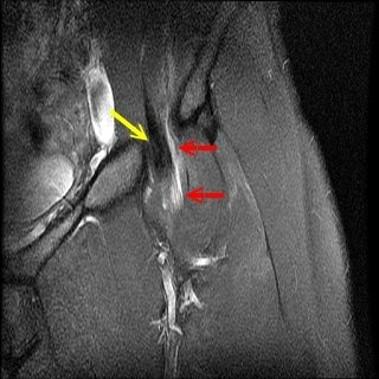The patient was feeling better and did not visit the orthopedic physician for 6 weeks. She returned today to get opiate refills.
Although her upper back pain has improved, she complains to her son of persistent groin and left hip pain with limited range of motion. A magnetic resonance imaging (MRI) scan was ordered, which revealed no fracture but a complete, spontaneous left iliopsoas tear. She was sent back to her primary care provider for pain management and follow up.
Pain on the IASP Faces Scale hovers over 4-5. There is facial grimacing with left trochanteric manipulation, including flexion, adduction, and internal rotation.
Co-occurring complaints include morning headaches upon waking, new daytime somnolence, new intermittent confusion, constipation, and poor appetite associated with weight loss of 9 pounds in the past 6 weeks.
Physical Exam
Vital Signs
- BP 96/60
- P 92
- R 22 shallow
- O2 Sat 84% room air
Pain

General Appearance
Thin, cachectic older woman, moderate distress
Lungs
Soft expiratory wheezes; otherwise clear
Heart
Tachycardic, regular rhythm; no murmurs
Abdomen
Significant for weight loss. Soft, palpable liver tip, no masses, no tenderness to palpation
Extremities
Facial grimacing with left trochanteric manipulation, including flexion, adduction, and internal rotation. Walking is painful.
Skin
No rashes.
Musculoskeletal
Diminished strength, upper and lower extremities.
Neurological
Morning headaches on waking, new daytime somnolence, new intermittent confusion
Sleep Issues
- Morning headaches upon waking, O2 sat = 82%
- New daytime somnolence
- Mild confusion
New Issues
- Constipation
- Poor appetite
- Significant weight loss
- 9 pounds in a thin older woman
- In 6 weeks
Imaging
MRI of Mrs. Mondragon's left groin shows the following.

Lab Results
- ESR: 45
- CBC
- WBC: 4100
- RBC: 3.4
- Hgb: 12.1
- Hct: 29%
- Chem 7
- Glucose: 120
- Na: 135
- K+: 4.1
- Cl-: 102
- BUN: 19
- Creatine: 1.1
- Co2: 27
- UA
- SG: 1.015
- pH: 6.5
- leukocyte: -
- Blood: -
- Protein: -
Social History
Ms. Mondragon is a thin, 71-year-old, widowed, Hispanic Spanish-speaking kyphotic woman who lives alone on her son’s property in rural northern NM.
Psychiatric History
Unknown
Substance Abuse History
Tobacco history, cigarettes 35+ pack yr. Snuff use, daily. Patient has positive history for past heroin use with spouse.
Review of Systems
Pain on an IASP Faces Pain Scale hovers around 4-5. There is facial grimacing with left trochanteric manipulation including flexion, adduction and internal rotation. Co-occurring complaints include morning headaches upon waking, new daytime somnolence, new intermittent confusion, constipation, and poor appetite associated with significant weight loss in the past six weeks of 9 pounds.
Discharge to Home Course
- Patient is medically stabilized and pain managed with oral opioids and adjunct medications.
- Iliopsoas tendon ruptures may occur spontaneously in elderly women.1,2
- Pathologic tendon changes associated with chronic diseases such as rheumatoid arthritis, diabetes, hyperparathyroidism, corticosteroids, chronic renal failure, and obesity.3
- Complete iliopsoas tendon tears are described in elderly women, several of whom did not have significant trauma or an underlying systemic disease, suggesting that there may be a hormonal basis.1,2
- Clinically, generally present as groin or trochanteric pain, worsened by flexion and adduction of the hip.4
- Complete tendon tears may present with an anterior thigh mass or ecchymosis. Iliopsoas injuries may mimic other etiology like fracture of hip and thus may not be diagnosed unless clinically suspected or until an MRI is obtained.2
References
- Lecouvet FE, Demondion X, Leemrijse T, Vande Berg BC, Devogelaer JP, Malghem J. Spontaneous rupture of the distal iliopsoas tendon: clinical and imaging findings, with anatomic correlations. Eur Radiol. 2005; 15(11):2341-2346.
- Bui KL, Ilaslan H, Recht M, Sundaram M. Iliopsoas injury: an MRI study of patterns and prevalence correlated with clinical findings. Skeletal Radiol. 2008; 37(3):245-249.
- Lonner JH, Van Kleunen JP. Spontaneous rupture of the gluteus medius and minimus tendons. Am J Orthop. 2002; 31(10):579-581.
- Shabshin N, Rosenberg ZS, Cavalcanti CF. MR imaging of iliopsoas musculotendinous injuries. Magn Reson Imaging Clin N Am. 2005; 13(4):705-716. http://www.healio.com/orthopedics/hip/journals/ORTHO/%7B239BA2FC-8B65-4DAB-83C8-9C559F8FE128%7D/Iliopsoas-Tendon-Rupture

